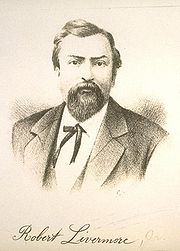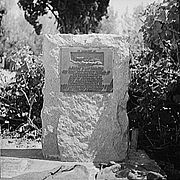
Robert Livermore
Encyclopedia

Robert Thomas Livermore (October 1799, Springfield
Springfield, Essex
Springfield has been a civil parish of the Borough of Chelmsford, Essex, England since 1907. The parish takes in the portion of the town north of river Chelmer and west of the A12 bypass and originally comprised the manors of Springfield Hall, Springfield Barnes, Cuton Hall, and in part New Hall...
Village, Essex
Essex
Essex is a ceremonial and non-metropolitan county in the East region of England, and one of the home counties. It is located to the northeast of Greater London. It borders with Cambridgeshire and Suffolk to the north, Hertfordshire to the west, Kent to the South and London to the south west...
, England – 14 February 1858) was a rancher and landowner in the early days of California
California
California is a state located on the West Coast of the United States. It is by far the most populous U.S. state, and the third-largest by land area...
, whose holdings eventually formed the basis of the city that bears his name: Livermore, California
Livermore, California
Livermore is a city in Alameda County. The population as of 2010 was 80,968. Livermore is located on the eastern edge of California's San Francisco Bay Area....
.
Biography
As a youth, Livermore was a mason's apprentice, but in 1816, he decided to go to sea, joining the crew of an English merchant ship. He subsequently was part of Lord CochraneThomas Cochrane, 10th Earl of Dundonald
Admiral Thomas Cochrane, 10th Earl of Dundonald, 1st Marquess of Maranhão, GCB, ODM , styled Lord Cochrane between 1778 and 1831, was a senior British naval flag officer and radical politician....
's crew in 1820 during Peru
Peru
Peru , officially the Republic of Peru , is a country in western South America. It is bordered on the north by Ecuador and Colombia, on the east by Brazil, on the southeast by Bolivia, on the south by Chile, and on the west by the Pacific Ocean....
's attempt to become independent from Spain. After Peru he signed on with an English trading ship bound for California.
In 1822, he arrived in San Pedro and met John Gilroy
Gilroy, California
Gilroy is the southernmost city in Santa Clara County, California, United States. The population was 48,821 at the 2010 census. Gilroy is well-known for its garlic crop and for the annual Gilroy Garlic Festival, featuring various garlicky foods, including garlic ice cream. Gilroy also produces...
. Livermore worked for a time at Mission San Gabriel and then moved north, working as the mayordomo (ranch foreman) at Rancho Bolsa del Potrero y Moro Cojo
Rancho Bolsa del Potrero y Moro Cojo
Rancho Bolsa del Potrero y Moro Cojo was a Mexican land grant in present day Monterey County, California given in 1822 by Governor Pablo Vicente de Solá to Joaquín de la Torre...
of Joaquín de la Torre, near Castroville
Castroville, California
Castroville is a census-designated place in Monterey County, California, United States. Castroville is located northwest of Salinas, at an elevation of 23 feet . The population was 6,481 at the 2010 census, down from 6,724 at the 2000 census. Castroville calls itself "Artichoke Center of the...
. On 20 June 1823, Robert was baptized at the Mission Santa Clara into the Catholic
Catholicism
Catholicism is a broad term for the body of the Catholic faith, its theologies and doctrines, its liturgical, ethical, spiritual, and behavioral characteristics, as well as a religious people as a whole....
faith, given the name Juan Bautista Roberto y José. At about the same time, in Monterey
Monterey, California
The City of Monterey in Monterey County is located on Monterey Bay along the Pacific coast in Central California. Monterey lies at an elevation of 26 feet above sea level. As of the 2010 census, the city population was 27,810. Monterey is of historical importance because it was the capital of...
, he requested and was given permission by Governor Pablo Vicente de Solá
Pablo Vicente de Solá
Pablo Vicente de Solá , the last Spanish governor of Alta California from 1815-1822....
to remain in California.
In 1834 Livermore and his business partner José Noriega were keeping livestock at Rancho Las Positas
Rancho Las Positas
Rancho Las Positas was a Mexican land grant in present day Alameda County, California given in 1839 by governor Juan Alvarado to Robert Livermore and Jose Noriega. Las Positas means "little watering holes" in Spanish...
, where they also built an adobe. They purchased half of the land grant from William Gulnac in 1837, and officially received the grant in 1839. The only other inhabitant of the area at the time, besides the Ohlone
Ohlone
The Ohlone people, also known as the Costanoan, are a Native American people of the central California coast. When Spanish explorers and missionaries arrived in the late 18th century, the Ohlone inhabited the area along the coast from San Francisco Bay through Monterey Bay to the lower Salinas Valley...
, was José Amador. Amador (his rancho was near the present city of Dublin
Dublin, California
Dublin is a suburban city of the East Bay region of Alameda County, California, United States. Located along the north side of Interstate 580 at the intersection with Interstate 680, roughly east of Hayward, west of Livermore and north of San Jose, it was named after the city of Dublin in...
) who received his land grant a short time earlier.
On 5 May 1838, Livermore married the widow Maria Josefa de Jesus Higuera Molina (1815–1879), daughter of Jose Loreto Higuera, grantee of Rancho Los Tularcitos
Rancho Los Tularcitos
Rancho Los Tularcitos was a Spanish land concession in present day Santa Clara County, California given in 1821 to José Loreto Higuera by the last Spanish governor of Alta California, Pablo Vicente de Solá. The land grant was confirmed by Mexican Governor Juan Alvarado in 1839. The name means...
, at the Mission San José. Josefa's grandfather, Ygnacio Higuera had been a member of Gaspar de Portolà
Gaspar de Portolà
Gaspar de Portolà i Rovira was a soldier, governor of Baja and Alta California , explorer and founder of San Diego and Monterey. He was born in Os de Balaguer, province of Lleida, in Catalonia, Spain, of Catalan nobility. Don Gaspar served as a soldier in the Spanish army in Italy and Portugal...
's Expedition Sancta in 1769 and had accompanied Juan Bautista de Anza
Juan Bautista de Anza
Juan Bautista de Anza Bezerra Nieto was a Novo-Spanish explorer and Governor of New Mexico for the Spanish Empire.-Early life:...
in his expedition of 1775–76. They first settled in the Suñol Valley
Sunol Valley
Sunol Valley is located in Alameda County, California, USA. The small town of Sunol lies in the valley. It is largely rural, but is in proximity to the highly populated Bay Area suburbs of Fremont, Pleasanton, and Livermore....
, but later moved to Las Positas, as he was making regular trips there to manage his rancho. Initially an adobe structure built by Livermore and Amador served as their house on the rancho. In 1850, a wooden two-story house was shipped around Cape Horn
Cape Horn
Cape Horn is the southernmost headland of the Tierra del Fuego archipelago of southern Chile, and is located on the small Hornos Island...
and became the Livermores' new home. Later the adobe structure was rented to Nathaniel Greene Patterson who used it as a small hotel, the first place of entertainment in the valley.
Livermore studiously avoided involvement in politics, and all evidence indicates he got along well with both the Mexican and Anglo communities. His only participation in the events surrounding the conquest of California was to help carry word from Commodore John Drake Sloat to John C. Frémont
John C. Frémont
John Charles Frémont , was an American military officer, explorer, and the first candidate of the anti-slavery Republican Party for the office of President of the United States. During the 1840s, that era's penny press accorded Frémont the sobriquet The Pathfinder...
at Sutter's Fort
Sutter's Fort
Sutter's Fort State Historic Park is a state-protected park in Sacramento, California which includes Sutter's Fort and the California State Indian Museum. Begun in 1839 and originally called "New Helvetia" by its builder, John Sutter, the fort was a 19th century agricultural and trade colony in...
that Monterey had been occupied by American forces, and that may have been partly motivated by the fact that Noriega had been captured during the Bear Flag Revolt and was being held at Sutter's Fort.

California Gold Rush
The California Gold Rush began on January 24, 1848, when gold was found by James W. Marshall at Sutter's Mill in Coloma, California. The first to hear confirmed information of the gold rush were the people in Oregon, the Sandwich Islands , and Latin America, who were the first to start flocking to...
, Livermore made no attempt to join the miners. Instead, in 1847 he and Noriega had purchased Rancho Cañada de los Vaqueros
Rancho Cañada de los Vaqueros
Rancho Cañada de los Vaqueros was a Mexican land grant mostly in present day Contra Costa County, California but partially in Alameda County, California given in 1844 by Governor Manuel Micheltorena to Antonio Higuera, Francisco Alviso and Manuel Miranda...
and added it to their holdings. When Alameda County, California
Alameda County, California
Alameda County is a county in the U.S. state of California. It occupies most of the East Bay region of the San Francisco Bay Area. As of the 2010 census it had a population of 1,510,271, making it the 7th most populous county in the state...
was formed in 1853, Livermore was appointed supervisor of roads in the county. In 1854 he purchased Noriega's half of Rancho Las Positas and deeded his half of Rancho Cañada de los Vaqueros to Noriega.
When Livermore died in 1858, he left behind Josefa and eight children. He was buried at Mission San José, but his grave was "lost" for over 100 years. The 1868 Hayward earthquake
1868 Hayward earthquake
The 1868 Hayward earthquake was the last large earthquake to occur on the Hayward Fault Zone in the San Francisco Bay Area, California, United States. It caused significant damage throughout the region, and was known as the "Great San Francisco Earthquake" prior to the 1906 San Francisco earthquake...
destroyed the church and it was replaced by a wooden structure. When that was torn down in 1981, workers discovered his original grave marker.
Robert Livermore never lived in the city that bears his name. William Mendenhall had met Livermore as part of Frémont's expedition, and when he founded the town in 1869, he named it after Livermore.

